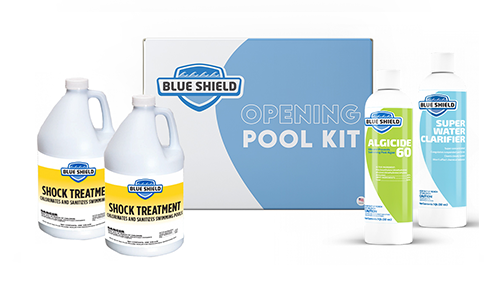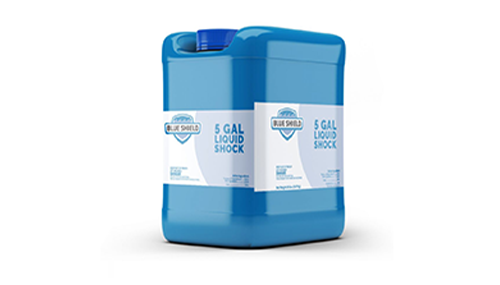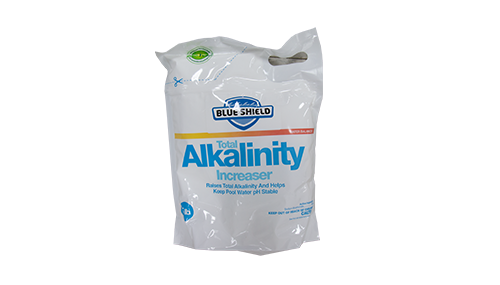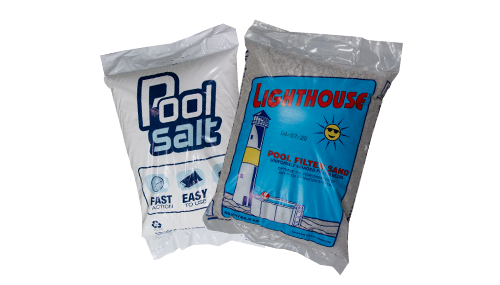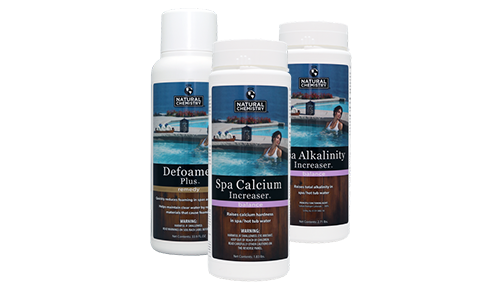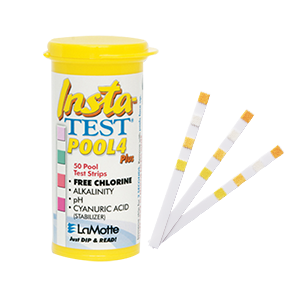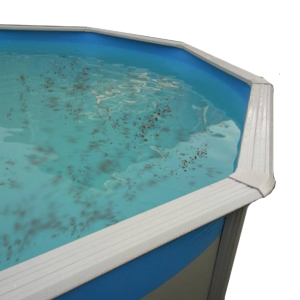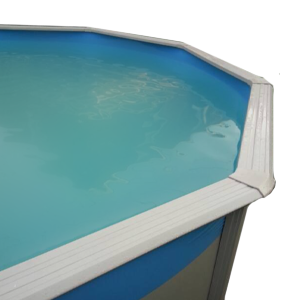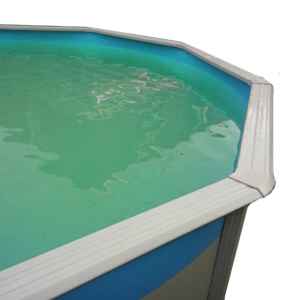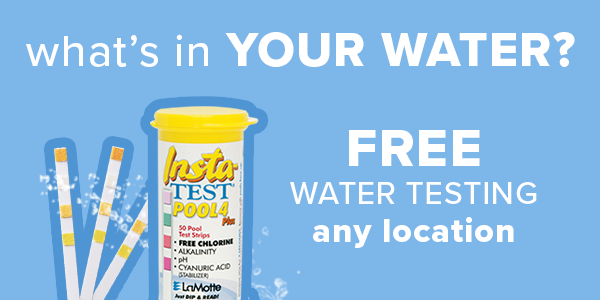Chemicals

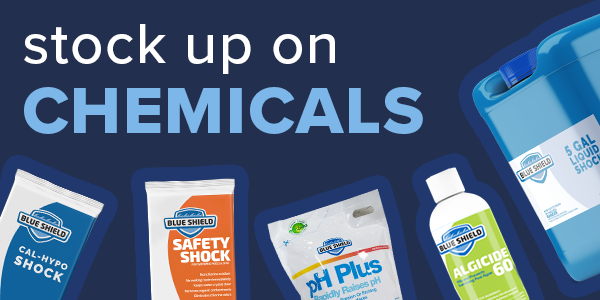
Shop by Problem
Resources & Tips to Do Chemicals Right
The power of
Blue Shield
Get the cleanest water possible at the best price with Namco's notorious Blue Shield line.
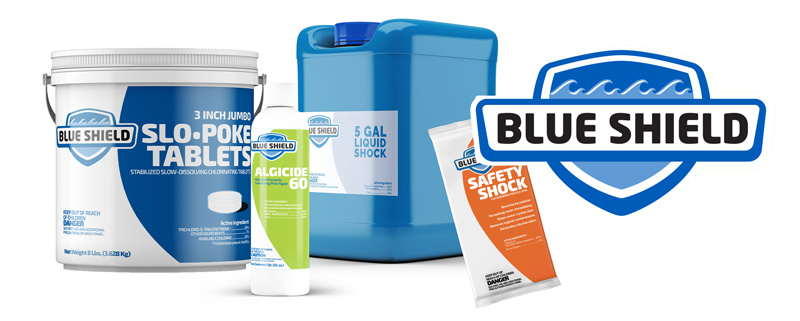

Pool Chemicals Explained
What is it?
This chemical is a sanitizer that keeps your water safe and clear of bacteria. As you already know, it is crucial to keep a balanced chlorine level at all times.
What happens when it's too low?
If your Chlorine is too low, then you run the risk of developing algae, and no one wants to clean that. It can cause other problems too. If you measure and discover it is in fact below 0, or you can visibly spot algae in the water, we recommend that no one swims in it until it is properly cleaned.
How often should I test my Chlorine?
If you have an automatic feeder you have the option to test it every few days. This chemical needs to be both tested and observed on a regular basis.
How to test Chlorine using test strips:
Dip your strip into a glass of water (not your sampling container!) and move it back and forth for 30 seconds. Alternatively, you can hold it under a stream of water for 10 seconds. The pads will change color to indicate Total Chlorine (white pad on end) and Free Chlorine (yellow pad). Hold your strip up to the chart to see your result.
What is the optimal PPM levels?
0 PPM: Not optimal, 0.5 PPM: Optimal, 1PPM: Good, 2PPM: Not Optimal, More than 2PPM: Bad. While chlorine in water isn’t considered dangerous until it reaches above 4 PPM, water with 2 PPM chlorine tastes and smells like chemicals. Further testing would be required to determine if chlorine content is above the 4 PPM threshold.
What are the recommended PH levels?
We recommend keeping your pH level here: 7.5 to 7.8. PH indicates how acidic or how basic water is.
How often should I test PH?
It needs to be tested daily to ensure the safety of your swimmers. As time wears on, you might not need to test it as often, although it is always a good idea to double-check it.
What happens if the PH is too low?
If you notice your pH levels are below 7.2, this might cause your eyes to sting and burn. f it dips below 6.8, it can damage metal pool equipment- especially pool heaters and/or copper heat exchange coils.
What happens in the PH is too high?
The higher the pH level climbs, it can eventually lead to calcium scaling.
What is it?
This chemical works hand in hand with your pH levels to keep them in balance with one another.
What happens if the PH is too low?
if your TA is too low, then the pH swings out of control.
What happens in the Alkalinity is too high?
Abnormally high levels can cause pH to rise (60-120.) When you measure your pool's TA, what you are really doing is checking the water’s ability to buffer any changes within its pH levels. If your TA is higher, this simultaneously increases the pH level. It is essential to keep both in balance at all times.
What does Calcium Hardness measure?
CH measures the amount of calcium in your water.
What happens if the PH is too low?
If your water has lower calcium levels it might dissolve calcium out of plaster, pebble, tile, stone, concrete, and sometimes even fiberglass surfaces. You can prevent this by saturating the water with calcium. With vinyl-lined pools, you do not need calcium to maintain it. If you have a plaster pool the CH levels should be 250-350. A fiberglass pool is the easiest one to deal with out of the three; calcium actually prevents fiberglass pools from staining and scaling. If you need to increase your CH use calcium chloride.
What happens in the Calcium Hardness is too high?
When maintained at appropriate levels, this chemical can prevent plaster damage. However, higher levels can cause calcium scaling (220-350 vinyl lower.)
Are Phosphates optional?
This one is entirely your choice. Although this chemical can keep algae levels down, it isn’t necessary for your pool water.
Which is better, Chlorine or Phosphate?
Chlorine is absolutely required, and in all honesty, is easier to maintain. Phosphate remover is too expensive and can oftentimes be difficult to use.
Spa Chemicals Explained
What is it?
This chemical is a sanitizer that keeps your water safe and clear of bacteria. As you already know, it is crucial to keep a balanced chlorine level at all times.
What happens when it's too low?
If your Chlorine is too low, then you run the risk of developing algae, and no one wants to clean that. It can cause other problems too. If you measure and discover it is in fact below 0, or you can visibly spot algae in the water, we recommend that no one swims in it until it is properly cleaned.
How often should I test my Chlorine?
If you have an automatic feeder you have the option to test it every few days. This chemical needs to be both tested and observed on a regular basis.
How to test Chlorine using test strips:
Dip your strip into a glass of water (not your sampling container!) and move it back and forth for 30 seconds. Alternatively, you can hold it under a stream of water for 10 seconds. The pads will change color to indicate Total Chlorine (white pad on end) and Free Chlorine (yellow pad). Hold your strip up to the chart to see your result.
What is the optimal PPM levels?
0 PPM: Not optimal, 0.5 PPM: Optimal, 1PPM: Good, 2PPM: Not Optimal, More than 2PPM: Bad. While chlorine in water isn’t considered dangerous until it reaches above 4 PPM, water with 2 PPM chlorine tastes and smells like chemicals. Further testing would be required to determine if chlorine content is above the 4 PPM threshold.
What are the recommended PH levels?
We recommend keeping your pH level here: 7.5 to 7.8. PH indicates how acidic or how basic water is.
How often should I test PH?
It needs to be tested daily to ensure the safety of your swimmers. As time wears on, you might not need to test it as often, although it is always a good idea to double-check it.
What happens if the PH is too low?
If you notice your pH levels are below 7.2, this might cause your eyes to sting and burn. f it dips below 6.8, it can damage metal pool equipment- especially pool heaters and/or copper heat exchange coils.
What happens in the PH is too high?
The higher the pH level climbs, it can eventually lead to calcium scaling.
What is the optimal PPM levels?
0 PPM: Not optimal, 0.5 PPM: Optimal, 1PPM: Good, 2PPM: Not Optimal, More than 2PPM: Bad. While chlorine in water isn’t considered dangerous until it reaches above 4 PPM, water with 2 PPM chlorine tastes and smells like chemicals. Further testing would be required to determine if chlorine content is above the 4 PPM threshold.
What is it?
This chemical works hand in hand with your pH levels to keep them in balance with one another.
What happens if the PH is too low?
if your TA is too low, then the pH swings out of control.
What happens in the Alkalinity is too high?
Abnormally high levels can cause pH to rise (60-120.) When you measure your pool's TA, what you are really doing is checking the water’s ability to buffer any changes within its pH levels. If your TA is higher, this simultaneously increases the pH level. It is essential to keep both in balance at all times.
What does Calcium Hardness measure?
CH measures the amount of calcium in your water.
What happens if the PH is too low?
If your water has lower calcium levels it might dissolve calcium out of plaster, pebble, tile, stone, concrete, and sometimes even fiberglass surfaces. You can prevent this by saturating the water with calcium. With vinyl-lined pools, you do not need calcium to maintain it. If you have a plaster pool the CH levels should be 250-350. A fiberglass pool is the easiest one to deal with out of the three; calcium actually prevents fiberglass pools from staining and scaling. If you need to increase your CH use calcium chloride.
What happens in the Calcium Hardness is too high?
When maintained at appropriate levels, this chemical can prevent plaster damage. However, higher levels can cause calcium scaling (220-350 vinyl lower.)
Why do we recommend it?
This is an optional enhancement to your pool water. It controls pH drift, balances algae issues, and can provide a unique ‘feel’ to your water supply. If you would like to add this chemical to your already pristine pool water, feel free to do so.
Should I test for Borate every day?
There are no necessary recommendations to test it, but you might want to keep it between 30-50 ppm.
Why do we recommend it?
This is an optional enhancement to your pool water. It controls pH drift, balances algae issues, and can provide a unique ‘feel’ to your water supply. If you would like to add this chemical to your already pristine pool water, feel free to do so.
Should I test for Borate every day?
There are no necessary recommendations to test it, but you might want to keep it between 30-50 ppm.
Are Phosphates optional?
This one is entirely your choice. Although this chemical can keep algae levels down, it isn’t necessary for your pool water.
Which is better, Chlorine or Phosphate?
Chlorine is absolutely required, and in all honesty, is easier to maintain. Phosphate remover is too expensive and can oftentimes be difficult to use.
